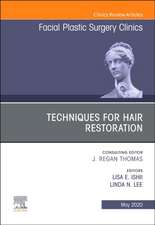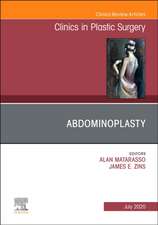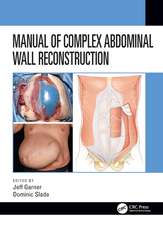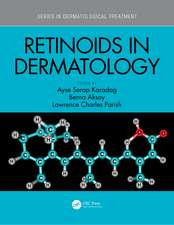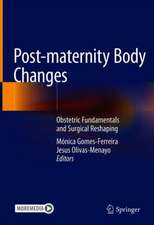Innovations and Advances in Wound Healing
Autor Seung-Kyu Hanen Limba Engleză Hardback – 28 mar 2023
| Toate formatele și edițiile | Preț | Express |
|---|---|---|
| Paperback (1) | 718.83 lei 39-44 zile | |
| Springer Berlin, Heidelberg – noi 2016 | 718.83 lei 39-44 zile | |
| Hardback (1) | 1138.64 lei 3-5 săpt. | |
| Springer Nature Singapore – 28 mar 2023 | 1138.64 lei 3-5 săpt. |
Preț: 1138.64 lei
Preț vechi: 1198.56 lei
-5% Nou
Puncte Express: 1708
Preț estimativ în valută:
217.92€ • 229.90$ • 181.61£
217.92€ • 229.90$ • 181.61£
Carte disponibilă
Livrare economică 12-26 decembrie
Preluare comenzi: 021 569.72.76
Specificații
ISBN-13: 9789811998041
ISBN-10: 9811998043
Pagini: 407
Ilustrații: XII, 407 p. 342 illus., 319 illus. in color.
Dimensiuni: 178 x 254 mm
Greutate: 1.07 kg
Ediția:3rd ed. 2023
Editura: Springer Nature Singapore
Colecția Springer
Locul publicării:Singapore, Singapore
ISBN-10: 9811998043
Pagini: 407
Ilustrații: XII, 407 p. 342 illus., 319 illus. in color.
Dimensiuni: 178 x 254 mm
Greutate: 1.07 kg
Ediția:3rd ed. 2023
Editura: Springer Nature Singapore
Colecția Springer
Locul publicării:Singapore, Singapore
Cuprins
1. Basics of Wound Healing.- 1) Clinical Anatomy of the Skin.- 2) Wound Overview.- 3) Wound Healing Process.- 4) Conventional Wound Healing Methods.- 2. Interactive Wound Dressings.- 1) Overview.- 2) Classification.- 3) Polyurethane Foam Dressing.- 4) Bioelectric Dressing.- 5) Antimicrobial Dressing.- 6) Dressing Selection.- 3. Biologic Dermis Graft.- 1) Autogenous Dermis Graft.- 2) Allogenic Dermis Graft.- 3) Artificial Dermis Graft.- 4. Tissue-engineered Dermis Graft.- 1) Artificial Dermis vs Tissue-Engineered Dermis.- 2) Fibroblast-Seeded Artificial.- Dermis.- 3) Adipose-Derived SVF Cell- Seeded Artificial Dermis.- 5. Usefulness of Fibrin Glue.- 1) Delivery Vehicle.- 2) Tissue Adhesive.- 3) Microsurgery.- 6. Unique Surgical Technique.- 1) Arterial Island Flap.- 2) Venous Island Flap.- 3) Staged Excision Technique to Reduce Scar Length.- 7. Management of Chronic Wounds - With Focus on Diabetic Ulcers.- 1) Why is Diabetic Ulcer Focused on?.- 2) Why does Diabetic Ulcer Get into Trouble?.- 3) Factors Contributing Delayed Healing.- 4) Risk Factors for Major Amputation.- 5) Management of Ischemia.- 6) Necessity of Collaboration.- 7) Developing Wound Dressing Team.- 8) Present and Future.- 8. Significance of Skin Hydration Level.- 1) Peripheral Neuropathy and Skin Hydration.- 2) Microangiopathy and Skin Hydration.- 3) Skin Hydration and Diabetic Wound Healing.- 9. Infection, Debridement, and Biofilm.- 1) Diagnosis.- 2) Microbiology of Diabetic Foot Infection.- 3) Treatment.- 4) Debridement.- 5) Biofilm.- 10. Negative-Pressure Wound Therapy (NPWT).- 1) Composition of NPWT Device.- 2) Mechanism of Action.- 3) Clinical Application.- 4) NPWT in Diabetic Foot Ulcers.- 11. Growth Factor Therapy.- 1) Overview.- 2) Background.- 3) Platelet-derived Growth Factor.- 4) Basic Fibroblast Growth Factor.- 5) Epidermal Growth Factor.- 12. Cell Therapy.- 1) Overview.- 2) Fibroblasts.- 3) Keratinocytes.- 4) Adipose-Derived SVF Cells.- 5) Platelet Concentrates.- 6) Mesenchymal StemCells.- 7) Adipose Derived Stem Cells.- 8) Limitations.- 13. Adipose Tissue and Its Derivatives.- 1) SVF Cells for Wound Coverage.- 2) SVF Cell Injection.- 3) Adipose Derived Stem Cells.- 4) Micronized Adipose Tissue Niche.- 14. Adjunctive Therapy.- 1) Nutritional Support.- 2) Electrical Stimulation.- 3) Ultrasound.- 4) Oxygen Therapy.- 5) Monochromatic Infrared Energy.- 6) Ultraviolet Light.- 7) Pain Scrambler Therapy.- 8) Foot Massager Device.- 9) Extracorporeal Shock Wave Therapy.- 15. Injectable Tissue-engineered Soft Tissue.- 1) Injectable Soft Tissue Using Fibroblasts suspended in Hyaluronic Acid Filler.- 2) Injectable Soft Tissue Using Fibroblasts.- 3) Injectable Soft Tissue Using Adipose-Derived Cells.
Notă biografică
Seung-Kyu Han, MD, PhD., is a professor in Plastic surgery at Korea University College of Medicine and a director of Diabetic Wound Center at Korea University Guro Hospital.
Textul de pe ultima copertă
This book presents state of the art knowledge on new techniques and materials that can improve functional and aesthetic results in wound healing while reducing invasiveness, based on the author's extensive personal experience. The aim is to equip the practitioner with all the information required in order to select a strategy that will accelerate wound healing and minimize both the risk of complications and scar formation after the wound has fully healed. The opening chapters set the stage by providing an overview of wound healing, including brief descriptions of the anatomy of the skin, the wound healing process, and advanced wound dressings. A full description follows of the various methodologies employed in repairing acute wounds with the goal of achieving optimal functional and cosmetic outcomes while utilizing the safest and least invasive method. Treatment protocols that have proven successful in closing nonhealing and/or delayed healing chronic wounds are then presented. In addition, a chapter addresses aesthetic procedures using advanced technology in wound healing. The closing chapter presents author's experience with the establishment a hospital wound dressing team. The text is complemented by a comprehensive collection of full-color photos. Since the publication of the second edition, there have been many notable advances in wound healing research. The third edition is expanded and updated to reflect the advancements and new information. Key revisions include new chapters and/or sections on recently developed dressings such as a bioelectric dressing, a fluorescence imaging device of bacteria, usefulness of fibrin glue to support wound healing, graft of 3D-printed micronized adipose tissue, significance of skin hydration level for wound healing, novel staged excision technique to reduce scar length, newly developed risk scoring system to predict wound healing outcomes in diabetic patients, expanded coverage of cell therapy, new devices such as extracorporeal shock wave therapy, and automated SVF cell isolation system.
Caracteristici
Presents state of the art knowledge on new techniques and materials Describes strategies that accelerate wound healing and minimize complications and scar formation Incorporates an extensive collection of full-color photos
Recenzii
“The author wishes to offer a novel approach to wound healing that will minimize risk and optimize the benefits. … General or plastic surgeons who wish to learn more about the difficult task of healing complicated wounds will find value in this book.” (Jeffrey S. Rosenthal, Doody’s Book Reviews, April, 2016)

